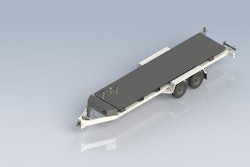
Climate change is among today’s most heated debates and social causes, prompting global corporations to re-write their business strategies to reduce and eventually meet a zero-carbon emission footprint. Greenhouse gas (GHG) emissions are at the heart of climate change discussions, with global economic activity producing carbon dioxide (CO2) levels estimated to be 50% over pre-industrialization levels.
Companies in the building and construction industries are facing tremendous pressure from critical stakeholders, environmental groups, customers and shareholders to find ways to reduce GHG output from their manufacturing facilities and construction partners.
These challenges are further exacerbated by material shortages such as siding, windows, framing and roofing, causing building delays for clients. This is important to note, since 87% of construction firms report customer retention is a driving force for their sustainability focus today.
Climate Change Is Impacting Builders On Many Levels
Over the past few years, more builders and their construction partners have taken steps to initiate these ESG plans and goals. Complicating matters further, the U.S. Securities and Exchange Commission (SEC) recently issued a proposed rule that would enhance and standardize the climate-related disclosures provided by public companies.
Under the proposal, a registrant will be required to adhere to GHG emissions disclosures within qualitative governance disclosures within their annual reports (e.g., Form 10-K). Aside from adhering to GHG improvements, companies must document their emissions certifications for SEC filings.
This is critical because equipment that services the construction industry, such as medium- and heavy-duty vehicles, including tractor-trailers, large pickups and vans, delivery trucks, and garbage trucks, produce about 24% of transportation emissions.
How Can Construction Transportation Fleets Progress?
A significant industry challenge revolves around answering the question of how to efficiently progress the construction industry toward a carbon-free future in a viable way. It’s a significant challenge and many builders today are seeking the right solution.
Companies that operate heavy-duty truck fleets in construction continue to deliberate the best strategy and approach. They want to do what’s right for their key stakeholders; customers, employees, an environmentally-conscious public, and shareholders. However, the economics of electric-battery technology, hydrogen, and other alternative energies are not yet viable today for U.S. long-haul transportation, and perhaps not for a few more decades for these operations.
Identifying A Realistic Bridge To Fuel Alternate Technologies
The best approach to realistically bridge today’s clean-diesel technology into tomorrow’s alternate fuel options is by leading with the appropriate ESG roadmap supported by strategic asset management partners to determine truck procurement strategies with optimal life cycle management. This will maximize environmental considerations and organically progress toward alternate fuel technology. In doing so, fleets will achieve critical ESG goals and continuously operate the most appropriate equipment for their operation.
Critical to these companies and their fleets is appropriately managing their Total Cost of Ownership (TCO) through accurate truck Life Cycle Cost Management (LCCM). With the advance in asset management and business intelligence, the transportation industry is paying closer attention to their trucks' life cycles to understand where they can drive sustainability and cost measures by optimizing replacement cycles.
Rather than extending the truck’s use for several years, companies are leveraging fleet modernization studies and innovative emissions scorecards that scrutinize each truck’s performance data and economic factors to determine an optimum procurement and disposal strategy.
The emissions scorecard reviews the entire fleet by year, make, model and compares fuel and mileage data and provides detailed information on CO2 , nitrous oxides (NOx) and particulate matter (PM) reduction in metric tons and gallons of fuel saved, each time the truck was replaced, as well as forecasted savings.
By shortening asset life cycles, optimizing vehicle specification to be more fuel-efficient, and aligning with the duty cycle as well as geographical locale, analytics-driven business intelligence is driving better asset management decisions to execute on the environmental criteria through a continuous reduction in emissions, fuel consumption and waste oil.
In addition to reduced emissions, proper LCCM results in improved safety records, and driver retention objectives while lowering maintenance expenditures and the company’s Total Cost of Ownership.
Real, Actual Data Proves The Difference
A data-driven LCCM plan is helping fleets make actionable changes for the benefit of their financial bottom line, as well as the environmental bottom line. The average driving mpg for a 500-unit fleet operating a five-year life cycle is 8.41. The average mpg for an eight-year life cycle is 7.90. Organizations have switched from an 8-year life cycle to a 5-year life cycle, which resulted in a net total reduction of 2.49 million gallons of fuel. This has a significant impact over five to 10 years, producing a potent reduction in CO2 of 25,122 metric tons and 6.1%.
Additionally, emissions scorecard data shows that upgrading to a 2024 model year truck from a 2018 model would provide 16% increase in fuel economy and reduction of CO2 emissions. These metrics are backed by data, allowing a supply chain organization that typically runs a truck for seven to 10 years to shift to a four-year life cycle, making a more significant impact toward a greener and more sustainable planet.
Industry-wide change doesn’t happen overnight. This industry has operated under legacy thinking and philosophies for many decades. We began this campaign and instituting change back in 2014 and the industry did not instantaneously react to changes. However, as the focus on environmental importance and stewardship grew in importance, and ESG strategies became more of a priority, fleets began to receive, accept and adapt this message. This was further emphasized when these organizations saw real impact through actual data.
Today, we have taken a step further by implementing actual conversions to electric vehicles and alternate fuels where it makes the most practical and applicable sense, but we are doing it where the data tells us it makes sense, not just because mainstream headlines are continuously offering pressure to change for the sake of popularity. And to help companies with their SEC disclosures, we recently introduced a new certification program to help corporate truck fleets certify their greenhouse gas emissions output to help them be as transparent as possible to key stakeholders.
We believe that fleets in building and construction that are positioned as true industry leaders will remain patient and make decisions based on real data and metrics without basing decisions on outside pressure that is only focused on popularity.


















